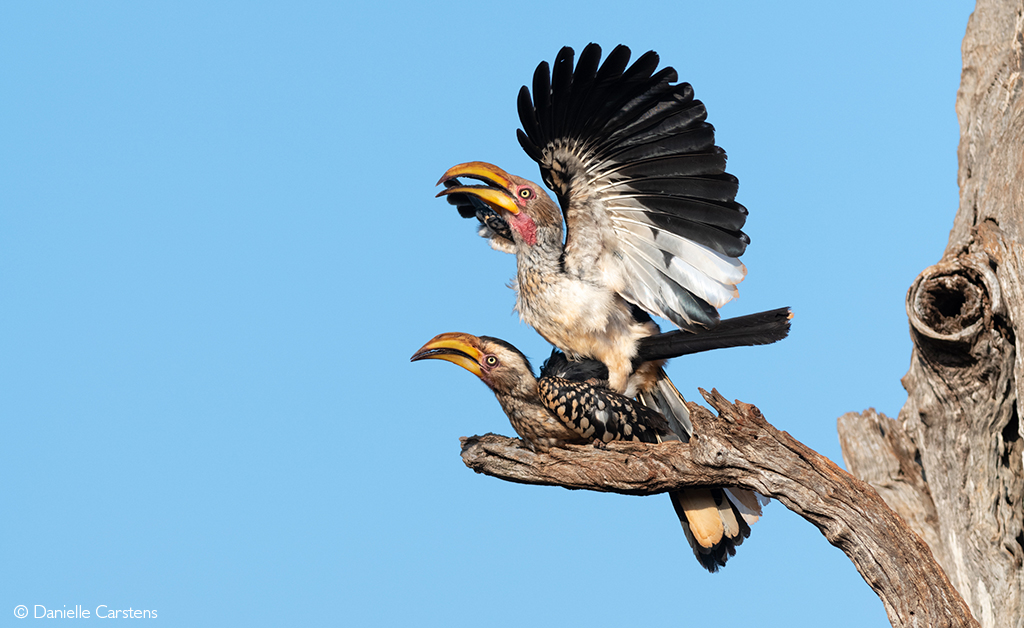
Scientists have predicted that the Kalahari’s hornbills will start to vanish in five years – and climate change is to blame. It is a frightening thought that an animal as seemingly ubiquitous as the yellow-billed hornbill could be threatened with local extinction. Yet the authors of a new study published in Frontiers warn that if temperatures continue on the same trajectory, yellow-billed hornbills at their study site in the Kalahari Desert will no longer be able to breed successfully by 2027 – resulting in local extinction.
Researchers in the Kuruman River Reserve in the Northern Cape of South Africa released their alarming results after a decade-long monitoring period, from 2008 to 2019. This included the drought during the 2015/2016 breeding season. The scientists compared the first three years of breeding data to the final three years of the study period. They found that nest success (defined by the successful fledging of at least one chick) declined from 58% to 17%, occupied artificial nest boxes declined from 52% to 12%, and the average number of chicks for each breeding attempt plummeted from 1.1 to 0.4. Most concerningly, of the 118 observed breeding attempts, not a single attempt was successful when the average air temperature was equal to or over 35.7˚C. According to current predictions, this average temperature will be exceeded for the entire duration of the yellow-billed hornbills’ breeding season by 2027, resulting in a predicted 0% breeding success rate.
Mass die-off events affecting bird species due to short periods of extreme temperatures are becoming increasingly common. However, this research shows that even sub-lethal increases in temperatures have a significant impact on the ecology of a region. Furthermore, hornbills would be expected to struggle during periods of drought due to a shortage of their insect and reptile prey. During the breeding season, the female yellow-billed hornbill seals herself off in a cavity of a tree or earth bank (or in artificial nest boxes) and is entirely reliant upon the male to feed her as she incubates the eggs and cares for the chicks. Thus, a shortage of resources caused by drought would hamper this process. Yet even in years of good rain, high temperatures still had deleterious effects on hornbill breeding habits.


The authors acknowledge that the higher temperatures inside artificial nest boxes compared to those of natural nest cavities may have impacted the results. However, the temperatures at the study site are, on average, lower than those experienced by yellow-billed hornbills at the hottest margins of their range. In addition, the effects of the higher temperatures are felt not just by the nesting female and chicks but by the males foraging for food during the day. Hornbills cannot shift their breeding season in the desert because it has to correspond with the arrival of the rains (and an abundance of prey) at the hottest time of the year. Climate change is changing temperatures (and other parameters) too quickly for birds to be able to adapt.
This research adds to a growing body of evidence of the effects global heating will have on Africa’s fauna and flora. With their relatively small body sizes, high metabolisms, and primarily diurnal activities, birds are especially vulnerable to changes in temperature and water availability. Those that survive in arid habitats like the Kalahari more so, as the window for successful breeding is limited to the duration of a short rainy season during the hottest months. According to the 2022 update to the State of the World’s Birds report, climate change now ranks as the second-greatest threat to birds across the globe after habitat destruction. Ornithologists are constantly finding new changes in bird behaviours and habits: climate change is affecting migratory patterns, seasonal rhythms, habitat and breeding ground use and even body size. The yellow-billed hornbills of this particular study represent challenges being faced by birds around the world.
And the threats posed are looming sooner than most people realise. As lead author Nicholas Pattinson explains in a press release from the University of Cape Town, “[m]uch of the public perception of the effects of climate change is related to scenarios calculated for 2050 and beyond. This renders the concept of the effects of climate change abstract to much of the general public not directly affected by extreme weather events, given that the effects are considered to concern future generations.”
Reference
Pattinson Nicholas B., van de Ven Tanja M. F. N., Finnie Mike J., Nupen Lisa J., McKechnie Andrew E., Cunningham Susan J. (2022), “Collapse of Breeding Success in Desert-Dwelling Hornbills Evident Within a Single Decade”, Frontiers in Ecology and Evolution. 10.
To comment on this story: Login (or sign up) to our app here - it's a troll-free safe place 🙂.![]()








